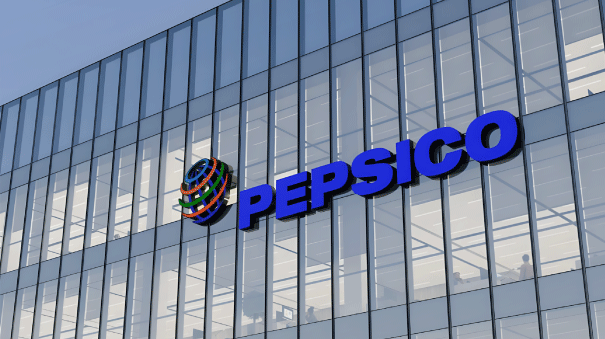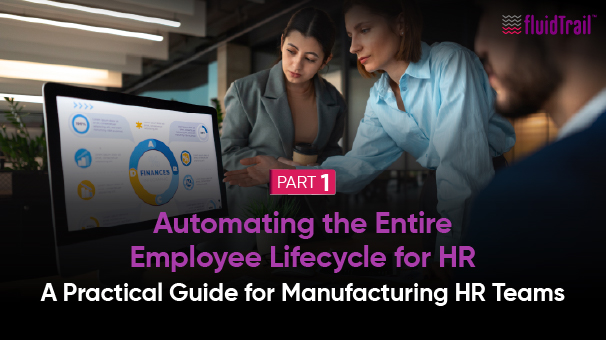📘Part 1: From Pre-Onboarding to Internal Transfers
By Naveena Joy, AGM – HR at Superon-Schweisstechnik India, Powered by fluidTrail
The Lifecycle Bottleneck No One Talks About,
In manufacturing, where people and productivity are deeply intertwined, HR teams face a paradox. On one hand, the workforce is growing more complex—with distributed teams, plant workers, contractual labor, and high attrition. On the other, HR operations remain largely manual, siloed, and paper-heavy.
The answer? End-to-end employee lifecycle automation!
Watch our latest webinar on detailed process here.
Why HR Teams in Manufacturing Sector Needs Employee Lifecycle Automation?
In most manufacturing setups, employees go through multiple touchpoints: from onboarding and training to internal transfers, compliance checks, and eventual exits. Each stage involves documents, signatures, approvals, hardware provisioning, and coordination across HR, IT, admin, payroll, and factory operations.
In a high-volume, high-turnover environment, manual processes simply don’t scale. Automation isn’t a luxury—it’s an operational necessity.
Top drivers pushing automation adoption:
- Growing workforce size across multiple plants and units
- Need to reduce time-to-productivity
- Compliance mandates (e.g., ISO, EHS, wage laws)
- Security risks due to poor offboarding practices
- Cumbersome employee file/document audits
Key Challenges in Manual Onboarding and Offboarding
Despite growing HR tech awareness, many manufacturing HR teams still rely on:
- Excel sheets and email chains
- Physical document collection and storage
- Delayed coordination with IT and admin
- Minimal performance tracking or L&D workflows
- Poor documentation for internal transfers
- Risky or delayed offboarding routines
Top challenges include:
- Delayed document collection due to lack of DMS
- Missed compliance checkpoints (e.g., EHS, ISO training)
- Manual clearance workflows during employee exit
- Overburdened HR teams running follow-ups
✅ The Benefits of Automating the Entire Employee Lifecycle
From pre-joining to offboarding, automating each touchpoint offers exponential value:
| Benefit | Description |
|---|---|
| ⏱️ Time-Saving | Auto-routing tasks, documents, and approvals |
| 📁 Centralized DMS | Single source of truth for employee records |
| 🔐 Audit Readiness | Every workflow is logged and timestamped |
| 🔄 Scalability | Onboard 5 or 500 employees – same system |
| 🌐 Cross-Functional Coordination | Alerts IT, Admin, Payroll instantly |
| 😊 Better Experience | Structured, predictable journeys for employees |
Stage-Wise Automation Breakdown
Stage 1: Pre-Onboarding Automation
Before Day 1, there’s chaos – emails, missing proofs, delayed provisioning. This is where automation brings order.
Pre-Onboarding Tasks You Can Automate with fluidTrail:
- ✅ Offer letter e-signatures and documentation
- ✅ Auto-generation of employee record in HRMS/DMS
- ✅ Digital welcome kit and policy pack distribution
- ✅ PAN, Aadhaar, bank proofs via secure upload links
- ✅ IT and Asset provisioning tickets
- ✅ Background verification triggers
By using fluidTrail’s pre-configured, no-code onboarding workflows, HR’s can create an automated document checklist that routes to respective stakeholders and updates employee status once completed.

fluidTrail framework for workflow automation.
Stage 2: Day-One Onboarding Experience
On Day 1, employees should focus on induction – not paperwork
Automate These Activities:
- Auto-launch of induction checklist
- Departmental notifications to Managers, Admin
- Auto-track asset handover (ID cards, uniforms, safety gear)
- Auto-enroll into compliance modules (EHS, ISO, PF registration)
- Set up performance goal templates or KRA documents

Stage 3: Confirmation & Probation Reviews
Most manufacturing companies run 90-day or 180-day probation periods. Manually tracking these can lead to HR misses or unreviewed confirmations.
By using tools like fluidTrail HR’s can,
- Send automated alerts to HR & managers at the 80/85/180-day marks
- Auto-generate digital confirmation forms
- Collect performance feedback and approval digitally
- Update employee status and payroll inputs post-confirmation

Stage 4: Performance & Learning Workflows
In manufacturing, L&D is crucial – be it safety modules, upskilling, or ISO recertifications.
With Automating manufacturing workflows:
- Create employee-specific learning paths using skill matrix
- Set automated reminders for module completions
- Generate and store training certificates in DMS
- Auto-schedule quarterly performance check-ins
- Track completion rates and flag overdue actions
Stage 5: Internal Transfers
Transfers between plants, departments, or locations involve IT, Payroll, Admin, Factory Operations, and HR. Doing this manually? A nightmare.
Automated Transfer Workflow:
- Auto-generate transfer letters (template-based)
- Notify all departments (IT, Admin, Payroll, Operations)
- Auto-update employee master record and attendance logic
- Archive all documents under new department/team structure
Looking to Automate Your HR Lifecycle End-to-End?
If you’re a manufacturing HR leader struggling with high-volume hiring, compliance complexity, or document chaos – fluidTrail is built for you.
fluidTrail is a no-code/low-code HR workflow automation platform by Wepsol, designed to digitize and streamline every stage of the employee lifecycle – from onboarding to offboarding.
With built-in document management, dynamic approvals, automated alerts, and real-time status tracking, fluidTrail makes your HR operations faster, audit-ready, and employee-friendly.
📧 Ready to transform your HR workflows?
Reach out to us at 👉 marcom@wepsol.com
✅ This concludes Part 1 of this blog, In Part 2, we will cover:
- 🚪 Exit & Offboarding Workflows
- 🧰 Tools & Tech Stack
- 📊 Mock Use Case: A Manufacturing Company Case Study
- 📌 Step-by-Step Implementation Roadmap
🔗 Click here to continue to Part 2 of this blog: ⌛Automating Exit Workflows, Tech Tools, and Implementation Roadmap for Manufacturing HR Teams

